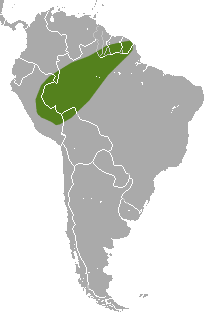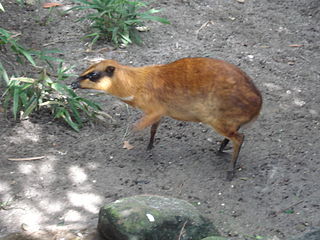The lesser Wilfred's mouse is a species of South American rodents of the family Cricetidae. It was first described by Wilfred H. Osgood under the name Thomasomys pictipes, then into the genus Wilfredomys, and now known as Juliomys pictipes. The lesser Wilfred's mouse is endemic to northeastern Argentina and southeastern Brazil. Its physical appearance ranges from dark brown to light orange coloration and the typical size is small to medium. This species is arboreal, spending most of its time trees and living in the local forests at altitudes from sea level to 2000 m. Currently, this species is listed as Least Concern by the IUCN, but, threats include livestock farming, ranching, and wood harvesting.
The Cochabamba grass mouse is a species of rodent in the family Cricetidae. It is found only in Bolivia. Its natural habitat is subtropical or tropical moist lowland forests.
Koopman's pencil-tailed tree mouse is a species of arboreal rodent in the family Muridae. It is endemic to Pagai and Siberut islands in the Mentawai Islands, off the western coast of Sumatra in Indonesia. Its natural habitat is tropical primary lowland forest. It is threatened by habitat loss (logging).
The Jico deer mouse is a species of rodent in the family Cricetidae found only in Mexico. Its natural habitat is subtropical or tropical moist lowland forests.
The beaded hylomyscus or beaded wood mouse is a species of rodent in the family Muridae. It is found in Burundi, Cameroon, Central African Republic, Republic of the Congo, Democratic Republic of the Congo, Equatorial Guinea, Gabon, and Uganda. Its natural habitats are subtropical or tropical moist lowland forest and subtropical or tropical moist montane forest.
Baer's hylomyscus or Baer's wood mouse is a species of rodent in the family Muridae. It is found in Ivory Coast, Ghana, and Sierra Leone. Its natural habitat is subtropical or tropical moist lowland forests. It is threatened by habitat loss.
The lesser hylomyscus or little wood mouse is a species of rodent in the family Muridae. It is found in Cameroon, Central African Republic, Republic of the Congo, Democratic Republic of the Congo, Gabon, and possibly Equatorial Guinea. Its natural habitat is subtropical or tropical moist lowland forests.
The Stella hylomyscus or Stella wood mouse is a species of rodent in the family Muridae. It is found in Burundi, Cameroon, Central African Republic, Republic of the Congo, Democratic Republic of the Congo, Equatorial Guinea, Gabon, Kenya, Nigeria, Rwanda, South Sudan, Tanzania, and Uganda. Its natural habitats are subtropical or tropical moist lowland forest and subtropical or tropical moist montane forest.
The servant mouse or Bonhote's mouse, is a species of rodent in the family Muridae. It is found only in the Western Ghats of South India, where it is restricted to Eravikulam National Park, Avalanche, Kalapatti, and Coonoor.
Phillips's mouse is a species of rodent in the family Muridae. It is found only in India. Its natural habitats are subtropical or tropical dry forests, subtropical or tropical dry lowland grassland, and hot deserts. It is threatened by habitat loss.
Misonne's soft-furred mouse or Misonne's praomys is a species of rodent in the family Muridae. It is found in Democratic Republic of the Congo, Kenya, and Uganda. Its natural habitats are subtropical or tropical moist lowland forest, subtropical or tropical moist montane forest, and arable land.
The forest soft-furred mouse or West African praomys is a species of rodent in the family Muridae. It is found in Ivory Coast, Ghana, Guinea, and Liberia. Its natural habitats are subtropical or tropical moist lowland forest and subtropical or tropical moist montane forest.

The white-edged tree frog is a species of frog in the taxonomic family Hylidae endemic to Brazil.
The Negros forest frog is a species of frog in the family Ceratobatrachidae. It is endemic to Panay and Negros, Philippines. It has been observed between 200 and 1800 meters above sea level.

The greater yellownape is a species of bird in the woodpecker family Picidae.

Kalinowski's mouse opossum or the Peru gracile mouse opossum is a species of opossum in the family Didelphidae. It is found in Brazil, French Guiana, Guyana, and Peru. Its natural habitat is subtropical or tropical moist lowland forests at elevations up to 1000 m.

The Colombian soft-furred spiny-rat, or arboreal soft-furred spiny-rat, is a species of rodent in the family Echimyidae. It is found in Colombia and Ecuador. Its natural habitat is subtropical or tropical moist lowland forests.

Nelson's spiny pocket mouse is a species of rodent in the family Heteromyidae. It is found in Mexico and Guatemala. Its natural habitat is subtropical or tropical moist lowland forests. It is threatened by habitat loss.

The brown hairy dwarf porcupine is a species of rodent in the family Erethizontidae. Found in the Andes in Colombia and Venezuela, its natural habitat is subtropical or tropical moist lowland forests. It is not easy to study as it is only known from a few specimens and wasn't recorded from 1925 until the 2000s. The porcupine is nocturnal and arboreal, feeding on leaves, shoots, and fruits. Habitat loss severely threatens it and it may even be extinct. Formerly listed as vulnerable, it is now designated data deficient. It is not known from any protected areas or conservation measures.

The greater mouse-deer, greater Malay chevrotain, or napu is a species of even-toed ungulate in the family Tragulidae found in Sumatra, Borneo, and smaller Malaysian and Indonesian islands, and in southern Myanmar, southern Thailand, and peninsular Malaysia. Its natural habitat is subtropical or tropical, moist, lowland forest.








